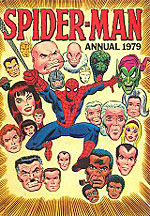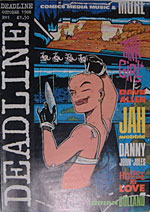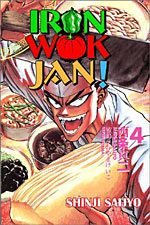>> Star of Macedonia: An interview with Ed Piskor
>> Comment: Craig's Last Hunt
More...

Matthew Craig is a thirty year-old writer from the West Midlands. A former research assistant on the Human Genome Project, he gave up a glittering career in laboratory science when it became clear that no radioactive spiders were ever going to bite him.
A current fixture of the Forecast, Matthew has been writing reviews and comment for Ninth Art for the past three years, as well as making contributions to Robot Fist and Punch Drunk Pop, while producing a steady stream of webcomics, both alone and with collaborators, through The Matthew Craig Dot Com.
SPIDER-MAN ANNUAL 1979
Stan Lee and Larry Lieber
 In almost three decades of reading comics, only two things have remained constant: first, there's never enough time or money to read everything I want or need to; and secondly, there's no getting around the fact that, for me, comics begin and end with Spider-Man.
In almost three decades of reading comics, only two things have remained constant: first, there's never enough time or money to read everything I want or need to; and secondly, there's no getting around the fact that, for me, comics begin and end with Spider-Man.
I can't remember my first comic, but this is the first comic I can remember. It's a British reprint of AMAZING SPIDER-MAN ANNUAL #4 from 1969, in which Spidey teams up with the Human Torch to fight Mysterio and the Wizard - and King Kong - out in Hollywood.
I've always seen something of myself in Peter Parker - or, at least, I've wanted to. It'd probably take months of analysis to properly separate out similarity from reader identification, but I've always sympathised with Peter Parker's need to be the best person that he can be, in the face of the myriad pressures he faces, from within and without. Also, I fight a lot of giant scorpions.
I more or less learned to read with this annual, and it ensured that words and pictures (and Spider-Man) would forever be joined in my mind.
TRANSFORMERS (UK) #1
Bill Mantlo, Ralph Macchio and Frank Springer
Everybody was into TRANSFORMERS at my school, just as they'd been into STAR WARS before it, and Marvel Comics before that. It turned out to be the last gasp of commonality my age group had before double figures arrived, bringing exams and hormones and Maria Whittaker with them.
My father bought me the first issue of the TRANSFORMERS comic, quite without prompting. I was off school, having broken my ankle playing 'tig', and I clearly needed cheering up. The cover featured a giant Walkman beating the shit out of a lorry with a handgun: it seemed to work.
I stayed with the title far longer than my peers, thanks primarily to the efforts of Simon Furman, who not only taught me how to make comics (in a 1986 TV interview I still have on tape), but proved that the Transformers could really live up to their motto of "More Than Meets The Eye".
DEADLINE #1
Various
 Unlike a lot of readers, I never drifted away from the medium in my teens. In fact, I had come to enjoy a wider range of material, from the politically charged 2000AD spin-off CRISIS to my first graphic novel, KRAVEN'S LAST HUNT. But the first really grown-up comic I ever bought (albeit sporadically) was DEADLINE magazine.
Unlike a lot of readers, I never drifted away from the medium in my teens. In fact, I had come to enjoy a wider range of material, from the politically charged 2000AD spin-off CRISIS to my first graphic novel, KRAVEN'S LAST HUNT. But the first really grown-up comic I ever bought (albeit sporadically) was DEADLINE magazine.
The first issue featured the debut of TANK GIRL, which completely owned me from page one with its sheer sense of abandon. But beyond that (and the yuppie machismo of JOHNNY NEMO), my favourite strip was Nick Abadzis' HUGO TATE. The stories had a grounding in youth and reality that belied Abadzis' visual gimmickry (Tate was an evolving cartoonish figure in a more or less realistic world). And as a sixth former with university (and, thereby, freedom) on his mind, HUGO TATE - and DEADLINE in general - promised a world of young adulthood that was much broader in scope than my dull hometown.
Whether it set me up to be disappointed, or whether my expectations outstripped my intrepidity is a question I'm still trying to answer today.
SPIDER-MAN 2099 #1-10
Peter David, Rick Leonardi and Al Williamson
I discovered my first dedicated comic shop around the same time that I made my first visit to the Big City. After a lifetime of rifling through racks of randomly-sourced American comics in newsagents, it was a revelation: a room the size of a small cinema filled to the brim with new comics, back issues, trade paperbacks and... I may have hyperventilated a little.
SPIDER-MAN 2099 gave me the excuse I needed to start going to the comic shop on a regular basis. And it was pretty bloody special, at least to begin with. The first ten issues were pure gold, a powerful re-examination of the Spider-Man "coming of age" story through the eyes of a callow adult protagonist. Peter David's scripts dripped with drama and droll wit, and Rick Leonardi and Al Williamson created a world of claustrophobic slums and immense superscrapers for the characters to inhabit.
It is this comic, above all others, that is responsible for making me a habitual consumer of American comics as an adult. And it doesn't hurt that, even a decade after their original publication, these early issues of SPIDER-MAN 2099 compare favourably to the best the character has to offer.
STRANGERS IN PARADISE
Terry Moore
I've never hidden my passion for comics from women. Indeed, they've been a useful icebreaker when the situation's called for it. But I've only shared actual comics with a woman once, and Strangers In Paradise was the most important of them. Which is why I can never read it again.
SiP wouldn't have worked with a lesser talent. It was full of the sort of storytelling clichés that, in other hands, would have seemed bilious and cringeworthy (one of the leads was an artist with a tortured soul, people kept blubbing for no good reason, there were poems). But Terry Moore was able to infuse the characters - and especially the art - with enough charm and wit to make it work.
I picked out SiP as something my lady friend might enjoy, and sure enough, we breezed through the first nine trade paperbacks during our time together. She identified with the sexually ambivalent and psychologically damaged Katchoo: I admired the raw drama, while lamenting the fact that, like the male lead, I wasn't going to get any.
We parted on bad terms, in the end. I tore up a comic to prove my love: she found out that it wasn't a very good one. She got the SiP comics, and I got the elbow. And while I can admire Moore for his skill and commitment to the series, I can't now look at STRANGERS IN PARADISE without thinking of her.
KANE
Paul Grist
One year I got to appear on a game show. I didn't win, but I did get a hotel room for the night and a refund on my train fare - which I promptly went out and spent on KANE.
I learned of Paul Grist's KANE through Wizard, of all things. The low-key melancholy of the eponymous detective, and the economy of both the dialogue and the art in creating a living, breathing city made KANE (and Grist's more recent JACK STAFF) some of my favourite comics of the last ten years, genuinely unlike anything else in my collection.
BIRDS OF PREY
Gail Simone and Ed Benes
Sometimes I think I have a slightly odd attitude to sex. I mean, don't get me wrong: I like a well-turned ankle as much as the next man. But when it comes to comics, I can be a bit of a puritan. Why, I'm not entirely sure: one of my first crushes was Carmine Infantino's Spider-Woman (in my defence, I was four, and didn't get the subtext). But if there's one thing in comics guaranteed to get my goat, it's the rather anodyne brand of cheesecake on display in mainstream superhero stories.
Part of my objection is aesthetic: a feeling that certain (high-profile) artists are better at drawing breasts than they are at drawing faces. Part of it is a sense that cheesecake can get in the way of telling a good story. But a lot of it, I think, is motivated by the fear that the world will somehow think less of comics (or possibly me) for giving in to its libido.
It's an irrational attitude, I know, and more than a little hypocritical - I'm not watching CHARMED for the gripping interpersonal drama, after all - but it's not entirely unfounded.
A story with an overt cheesecake style has to be pretty special to get past my dubious objections. BIRDS OF PREY qualifies. While Ed Benes' bootycentric art can be a little distracting, his action style is excellent. More importantly, I can't help being dragged along by Gail Simone's wit and emotional range, and the interaction between the three leads, each of whom has a unique reason for (and approach to) saving the world. BIRDS OF PREY may not have cured my 2D T 'n' A phobia, but it's gone a long way towards easing the pain of Catholic guilt.
IRON WOK JAN
Shinji Saijyo
 It took me a little while to get into Japanese comics. The formatting proved to be a bit of a stumbling block to begin with, even though my first manga had conveniently numbered panels to help the novice reader. I bravely soldiered on, buying a couple of classics here and there, but I never quite felt like I was getting the most out of my comics.
It took me a little while to get into Japanese comics. The formatting proved to be a bit of a stumbling block to begin with, even though my first manga had conveniently numbered panels to help the novice reader. I bravely soldiered on, buying a couple of classics here and there, but I never quite felt like I was getting the most out of my comics.
It wasn't until I read IRON WOK JAN that I really got the hang of the rhythms, the right-left format, and the iconography. And it was all because of the story. Shinji Saijyo's tale of a maverick chef and his ultra competitive cooking style was compelling stuff from the start. The malevolence of the lead, in contrast to his more traditionally hapless and feisty co-stars, was refreshing to say the least. The core themes of creative pride and self-improvement were new to me in the medium, and the uniqueness of and breathless enthusiasm for the setting shone through on every page.
It was addictive enough to make me go back for more IWJ a couple of days later, breaking my 'no more than one visit per week to the comic shop' rule for the first time in years. And it finally opened up the ever-expanding manga shelves to my hungry eyes.
After all, you can never have enough good comics.
THE MANHATTAN GUARDIAN
Grant Morrison and Cameron Stewart
But you can get pretty sick of bad ones.
I no longer read the main SPIDER-MAN titles. The character has been hammered into a new and unpalatable shape - one that is more about serving the needs of the latest sales-baiting stunt than exploring the major themes of the character. Peter Parker isn't a (relatively) ordinary man anymore, struggling to cope with conflicting lifestyle demands while striving to be able to face himself in the mirror. Instead, he has become the chosen avatar of a mysterious Spider-God, living in an ivory tower with the other superheroes, and a sugar daddy who picks out his clothes for him while spying on his wife in the bath. And while I enjoy the excellent ULTIMATE SPIDER-MAN, I still miss the version I grew up with.
DC's MANHATTAN GUARDIAN is as close to a Grant Morrison SPIDER-MAN as we are ever likely to get. Co-created with Cameron Stewart, and kicking off Morrison's Seven Soldiers project, MANHATTAN GUARDIAN shares themes of identity and redemption with the Marvel character. Both men regain their sense of self-worth by going out and interacting with a world they can't possibly hope to control, at the expense of a quiet life. Both characters are haunted by irrevocable mistakes, and both characters are inspired by the memories of wise older father-figures. Finally, and somewhat tenuously, the Guardian's father-in-law bears a strong resemblance to Spider-Man co-creator Stan Lee.
It's a great story in its own right, and as part of the compelling Seven Soldiers super story, but it's especially rewarding to read it as a story that echoes, without imitation, the stories and the character that got me into comics in the first place.

This article is Ideological Freeware. The author grants permission for its reproduction and redistribution by private individuals on condition that the author and source of the article are clearly shown, no charge is made, and the whole article is reproduced intact, including this notice.


